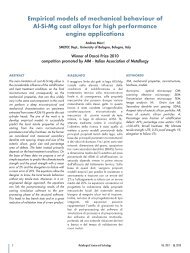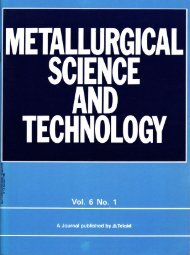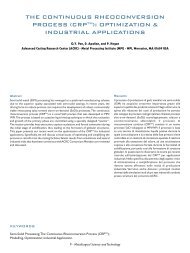PDF, about 5Mb - Teksid Aluminum
PDF, about 5Mb - Teksid Aluminum
PDF, about 5Mb - Teksid Aluminum
You also want an ePaper? Increase the reach of your titles
YUMPU automatically turns print PDFs into web optimized ePapers that Google loves.
and rapid hardening up to σ peaks located at ε~0.7,<br />
irrespective of the different strain rates, followed<br />
by a continuous softening towards the fracture<br />
that occurs at e larger than in AZ31; at 400°C and<br />
strain rate 0.05 s -1 the maximum strain value is<br />
2.5. The flow curve exhibiting a peak followed by<br />
softening in stationary state is indicative of dynamic<br />
recrystallization (DRX) that nucleates in proximity<br />
of the peak producing new stable grains whose<br />
size controls the softening and the σ of stationary<br />
state.<br />
In the present instance, the absence of stationary<br />
state and the decrease of σ up to fracture may be<br />
indicative of three processes promoting the<br />
continuous softening: (i) the onset of DRX around<br />
the peak, producing new small grains, (ii) the fast<br />
new-grain growth at the critical size for (iii) crack<br />
nucleation and growth.<br />
A significant decrease in the strain to failure in<br />
torsion can be observed (Figure 4), in particular<br />
in the high-temperature region; an additional<br />
difference is the observation of a well defined<br />
yielding in ZM21, (Figure 3) i.e. of the presence of<br />
a short strain range without load increase, an effect<br />
A)<br />
<br />
B)<br />
<br />
<br />
<br />
<br />
<br />
<br />
<br />
<br />
<br />
<br />
<br />
<br />
A)<br />
B)<br />
<br />
<br />
<br />
<br />
<br />
<br />
<br />
<br />
<br />
<br />
<br />
<br />
<br />
<br />
<br />
<br />
<br />
<br />
<br />
<br />
<br />
<br />
<br />
<br />
Fig. 3: Equivalent stress vs. equivalent strain curves obtained in torsion for<br />
ZM21 at 200 (a) and 400°C (b).<br />
<br />
<br />
<br />
<br />
<br />
<br />
<br />
<br />
<br />
<br />
<br />
<br />
<br />
<br />
<br />
<br />
<br />
<br />
<br />
<br />
<br />
<br />
<br />
<br />
<br />
<br />
<br />
<br />
<br />
<br />
<br />
<br />
<br />
<br />
<br />
<br />
<br />
<br />
<br />
<br />
26 - Metallurgical Science and Technology<br />
Fig. 2: Equivalent stress vs. equivalent strain curves obtained in<br />
torsion for AZ31 at 200 (a) and 400°C (b).<br />
probably due to a sudden increase in the number of<br />
dislocations unpinned from their solute atmosphere<br />
(either Zn or Mn).<br />
The temperature and strain rate dependence of the<br />
peak stress are shown in Figure 5. The experimental<br />
data are well described by the equation:<br />
ε& = A[ sinh(<br />
ασ)<br />
] n<br />
exp( −Q<br />
/ RT)<br />
3)<br />
where A and α are material parameters, n is a<br />
constant, R is the gas constant, T is the absolute<br />
temperature, and Q is the apparent activation energy<br />
for high-temperature deformation process. In the<br />
AZ31 a best-fitting procedure gave α=0.017 MPa-1 and n= 4.4 for temperatures between 200°C and<br />
400°C. The activation energy, calculated by plotting<br />
sinh(as) as a function of 1/T, was Q=140 kJ/mol. The<br />
value is relatively close to the one of self-diffusion of<br />
Mg (135 kJ/mol) or for diffusion of Al in Mg (143 kJ/<br />
mol). In the case of the ZM21, α was close to 0.049<br />
MPa-1 , and n ranged between 2.6 and 4.4 (average<br />
n=3.3). The activation energy for high temperature<br />
deformation was close to 200 kJ/mol, higher than in<br />
the case of AZ31.







